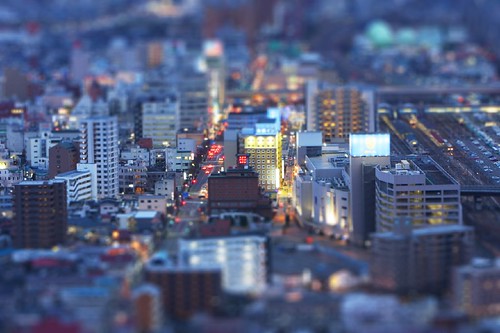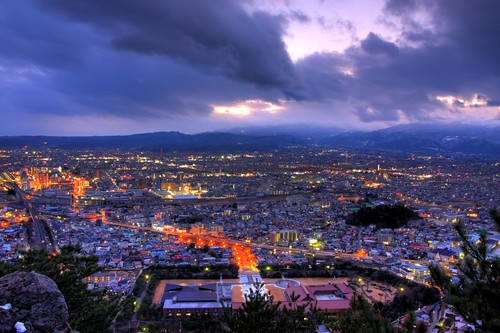The road leading to the city of Fukushima remains deserted, the silence broken only by the sirens of fire trucks that cross in the opposite direction. A poster adorned with spring flowers are invited to enter a place that everyone who has been escaped. Those who have left the street wear masks and protective in the intense cold waiting in endless queues in front of the few shops open.
"He had spent two days holed up at home and had nothing to eat," says the old Eiki while waiting their turn in front of the mall Nakago. Those who remain in their homes remain outstanding maps of radiation that is constantly displayed on television, showing the highest risk. Fukushima is outside the perimeter of 30 kilometers officially decreed by the government, but within 80 miles as the U.S.
government recommend (to plant 60kilómetros). Surprisingly, they are more people and cars on the streets two days ago, when the city was completely deserted. The people of this city of 350,000 inhabitants have the feeling of being trapped. It is not a drop of gasoline for three days and most could not flee on their own if there was a massive leak of radioactivity in the area.
Maiko Yusa, who works for the local beer company Asahi, says he has lived entrenched in his parents' house since the 9.0 magnitude earthquake that struck Japan on Friday collapsed home. "I can not stand being here, but my parents are older and do not want to leave," he laments. The Sports Center Azuma flag has been turned into a huge shelter for those who fled nearby nuclear plant, which has four of six reactors outside its control.
Technicians dressed in costumes and masks covered by checking the radiation levels of people waiting in orderly single file. A child clings to her mother's legs while the operator goes through the detector by your body. "Clean!" He says, while the mother delivered a certificate of non-contamination.
Take turns teens, women and elderly, some pushed in wheelchairs. Katsuko Mayana was evacuated from Soma, just 13 miles from the damaged nuclear plant, on Sunday. This woman of 64 years and three children is a triple refugee. The earthquake flattened his house, the tsunami forced her to flee to a shelter and the nuclear crisis has brought to the shelter where about 2,000 people sleep under the stars on the basketball court, the corridors and offices of a second plant.
Left behind a devastated town in which authorities say there are not enough crematoria to dismiss the victims. "I've lost everything. Where do you come from? Tell your country to come and help, "said the woman, lying on some blankets. A group of refugees sitting in front of a TV. Most are elderly and have a lost look, as if they had stopped attending the succession of images explosion at the nuclear plant, villages devastated by the tsunami and refugees as they are crammed into schools and hospitals.
Everything is organized with Japanese precision. The newspapers of the day perfectly placed on a table and the information center well attended. Even poster search of missing relatives are glued on a bulletin board in a linear and orderly. Mothers looking for children. Hijos parents. ...
brother to brother 


"He had spent two days holed up at home and had nothing to eat," says the old Eiki while waiting their turn in front of the mall Nakago. Those who remain in their homes remain outstanding maps of radiation that is constantly displayed on television, showing the highest risk. Fukushima is outside the perimeter of 30 kilometers officially decreed by the government, but within 80 miles as the U.S.
government recommend (to plant 60kilómetros). Surprisingly, they are more people and cars on the streets two days ago, when the city was completely deserted. The people of this city of 350,000 inhabitants have the feeling of being trapped. It is not a drop of gasoline for three days and most could not flee on their own if there was a massive leak of radioactivity in the area.
Maiko Yusa, who works for the local beer company Asahi, says he has lived entrenched in his parents' house since the 9.0 magnitude earthquake that struck Japan on Friday collapsed home. "I can not stand being here, but my parents are older and do not want to leave," he laments. The Sports Center Azuma flag has been turned into a huge shelter for those who fled nearby nuclear plant, which has four of six reactors outside its control.
Technicians dressed in costumes and masks covered by checking the radiation levels of people waiting in orderly single file. A child clings to her mother's legs while the operator goes through the detector by your body. "Clean!" He says, while the mother delivered a certificate of non-contamination.
Take turns teens, women and elderly, some pushed in wheelchairs. Katsuko Mayana was evacuated from Soma, just 13 miles from the damaged nuclear plant, on Sunday. This woman of 64 years and three children is a triple refugee. The earthquake flattened his house, the tsunami forced her to flee to a shelter and the nuclear crisis has brought to the shelter where about 2,000 people sleep under the stars on the basketball court, the corridors and offices of a second plant.
Left behind a devastated town in which authorities say there are not enough crematoria to dismiss the victims. "I've lost everything. Where do you come from? Tell your country to come and help, "said the woman, lying on some blankets. A group of refugees sitting in front of a TV. Most are elderly and have a lost look, as if they had stopped attending the succession of images explosion at the nuclear plant, villages devastated by the tsunami and refugees as they are crammed into schools and hospitals.
Everything is organized with Japanese precision. The newspapers of the day perfectly placed on a table and the information center well attended. Even poster search of missing relatives are glued on a bulletin board in a linear and orderly. Mothers looking for children. Hijos parents. ...
brother to brother



- High radiation levels outside Fukushima evacuation zone (17/03/2011)
- Low Levels of Radioactive Material Detected Across Pacific (18/03/2011)
- Vietnam helps citizens in Japanese quake areas (16/03/2011)
- U.S. Officials Don't Expect Radiation From Japan (18/03/2011)
- For many who fled danger in Japan, the nightmare continues (16/03/2011)
No comments:
Post a Comment